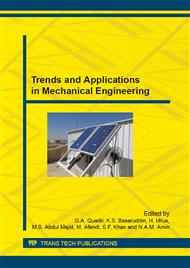[1]
W. E. Prentice, Arnheim's Principle of Athletic Training: A Competency Based Approach, 12thed. New York: Mc Graw Hill, (2006).
Google Scholar
[2]
C. M. Court-Brown, S. Aitken, TheEpidemiology of Acute Sports-Related Fractures in Adults, International Journal of the Case of the Injuried. 39 (2008) 1365-1372.
DOI: 10.1016/j.injury.2008.02.004
Google Scholar
[3]
H. C. K. Li, C. W. P. Li-Tsang, Sports Related Hand Injuries in Hong Kong, Hong Kong Journal of Occupational Therapy, 20 (2010) 1 13-18.
DOI: 10.1016/s1569-1861(10)70053-x
Google Scholar
[4]
R. Ding, Malunion and Nonunion of the Metacarpals and Phalanges, Journal of Bone and Joint Surgery, 87 (2005) 1380-1389.
Google Scholar
[5]
F. J. O'Brien, D. Taylor and T. C. Lee, The Effect of Bone Microctructure on the Initiation and Growth of Microcracks, Journal of Orthopaedic Research, 23 (2005) 475-480.
Google Scholar
[6]
N. A. Devries, S. C. Tadepalli, V. A. Magnotta, N. M. Grosland, IA-FE mesh: Anatomic FE models-A check of mesh accurancy and validity, The Iowa Orthopaedic Journal, 29 (2009).
Google Scholar
[7]
R. Daud, K. A. Ariffin, S. Abdullah, M. S. A. Majid and M. A. Rojan, Mathematical model of elastic crack unification interaction and two-dimensional finite element analyses based on Griffith energy release rate, Advance Materials Research, 795 (2013).
DOI: 10.4028/www.scientific.net/amr.795.587
Google Scholar
[8]
R. Daud, A.K. Ariffin, S. Abdullah, A. E. Ismail Computation of Mixed Mode Stress Intensity Factor for Parallel Edge Cracks, Applied Mechanics and Materials (AMM) Journal, 2011. ISSN: 1660-9336. Pp. 1326-1311.
DOI: 10.4028/www.scientific.net/amm.52-54.1326
Google Scholar
[9]
R. Daud, A.K. Ariffin, S. Abdullah, A. E. Ismail, J-integral Evaluation in Two Dimensional Interacting Cracks, Advanced Material Research Journal, 2011, ISSN: 1022-6680. Pp. 55-59.
DOI: 10.4028/www.scientific.net/amr.214.55
Google Scholar
[10]
R. Daud, A.K. Ariffin, S. Abdullah, A. E. Ismail, Z. Ahmad Computational of Stress Intensity Factor for Multiple Cracks using Singular Finite Element, Advanced Material Research Journal 2011, ISSN: 1022-6680. Pp. 75-79.
DOI: 10.4028/www.scientific.net/amr.214.75
Google Scholar
[11]
R. Daud, A.K. Ariffin, S. Abdullah, Fatigue Failure Analysis using Theory of Critical Distance, Key Engineering Materials (KEM) Journal, 2011. Indexed in SCOPUS and ISI; Impact factor: 2005: 0. 224. pp.663-667.
DOI: 10.4028/www.scientific.net/kem.462-463.663
Google Scholar


